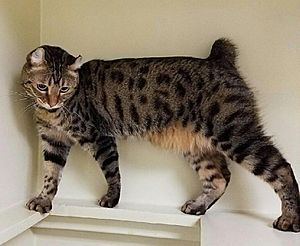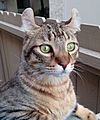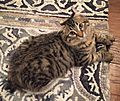Highlander cat facts for kids
Quick facts for kids Highlander |
|
|---|---|
 |
|
| Other names | Highlander Shorthair, Highland Lynx |
| Origin | United States |
| Foundation bloodstock | Desert Lynx and Jungle Curl, the latter a domestic–wild hybrid |
| Breed standards | |
| TICA | standard |
| Other | REFR recognized, no standard |
| Notes | |
|
TICA status is Preliminary New Breed, not yet eligible for championship competition.
|
|
| Feline hybrid (Felis catus × F. chaus × Prionailurus bengalensis) | |
The Highlander (also called the Highlander Shorthair) is a special type of cat breed. It was first known as the Highland Lynx. These cats have a very unique look. They were created by carefully mixing two other cat breeds: the Desert Lynx and the Jungle Curl. The Jungle Curl breed has some wild cat ancestors from Asia. This means the Highlander is technically a feline hybrid, but it is mostly a domestic cat and a loving pet.
Contents
What Makes a Highlander Cat Special?
The Highlander cat was first created by mixing the Desert Lynx and Jungle Curl breeds. The goal was to give the Desert Lynx's look the curled ears of the Jungle Curl.
Physical Features
Highlanders often have a short, "bobbed" tail, like a bobcat. Their fur can have spots or swirled patterns. They have a long, sloped forehead and a wide nose. Their eyes are set wide apart. Their ears stand up, curl slightly, and turn a bit backward. Some Highlanders even have extra toes, which is called being polydactyl.
Highlanders are strong and muscular cats. Female Highlanders usually weigh between 10 and 14 pounds. Males are bigger, weighing between 15 and 20 pounds.
Personality and Health
Highlanders are known to be friendly, playful, and confident cats. They love being around people. Even though they look like big wild cats, they are very gentle. They also enjoy playing in water! There are no known health problems specific to the Highlander breed. Their fur can be tabby (striped or spotted) or point coloration (darker fur on the ears, face, paws, and tail) in many different colors.
How the Highlander Breed Developed
The development of the Highland Lynx breed started in 1993. It was a mix of the experimental Desert Lynx breed and the Jungle Curl. The idea was to add the curled ears from the Jungle Curl to the Desert Lynx. Even though the name included "lynx," these cats do not have any real wild lynx or bobcat in their family tree.
Recognizing the Breed
The Rare and Exotic Feline Registry recognized the early Highland Lynxes. They placed them in a group with other "Lynx" breeds, like the Desert Lynx, Alpine Lynx, and Mojave Bob.
Becoming the Highlander
In 2004, breeders started to refine the breed. They wanted to make it more distinct from its parent breeds. They also wanted it to be recognized by major cat registries for competitions. The name Highlander was chosen in late 2005.
On May 1, 2008, The International Cat Association (TICA) recognized the Highlander. They allowed the breed to compete in the Preliminary New Breed class. In 2016, it moved up to the Advanced New Breed class. TICA actually divides Highlanders into two types: the Highlander Shorthair (HGS) for cats with shorter fur, and simply Highlander (HG) for those with longer fur.
Images for kids









